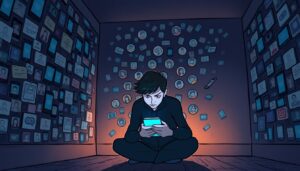Modern dating platforms have reshaped how we connect, but their design often prioritizes engagement over genuine relationships. Apps like Tinder and Bumble use gamified interfaces that reward constant interaction, creating patterns that mirror compulsive behaviors. What begins as casual profile browsing can evolve into hours of repetitive motion, draining energy and distorting expectations.
Many users report feeling trapped in cycles of endless scrolling, driven by the thrill of potential matches. These platforms employ psychological tactics similar to slot machines, delivering unpredictable rewards that keep people returning. Over time, this habit can overshadow real-life connections and reduce productivity.
Mental health professionals now recognize this behavior as part of broader technology-related challenges. Studies show compulsive app use activates brain regions associated with cravings, blurring the line between habit and dependency. The impact extends beyond screens, affecting sleep quality and interpersonal dynamics.
This guide explores practical strategies to regain control, drawing from behavioral science and success stories. You’ll learn to identify red flags, implement boundary-setting techniques, and rebuild healthier digital routines. Small changes can restore balance between virtual exploration and meaningful offline experiences.
Understanding Swipe Addiction in the Digital Age
The rise of mobile technology has introduced novel challenges in how we form romantic relationships online. Psychologists now recognize patterns of compulsive app engagement as a modern behavioral health concern. Dr. Kimberly S. Young’s pioneering research on internet addiction disorder laid groundwork for understanding these digital dependencies, revealing brain changes comparable to substance-related conditions.
What Is Swipe Addiction?
This specific behavioral pattern centers on dating platforms that turn human connection into gamified interactions. Unlike general internet overuse, it thrives on unpredictable rewards like matches or messages that trigger dopamine releases. Users often transition from casual app use to relying on these platforms for emotional validation, creating self-esteem ties to algorithmic approval.
How It Differs From Other Digital Dependencies
Social media habits typically seek broad social approval, while dating apps target romantic validation. Features like daily streaks and premium subscriptions exploit urgency, making disengagement harder than with other digital tools. The apps’ design creates unique vulnerabilities around body image and relationship skills, setting them apart from standard online behaviors.
Recognizing Swipe Addiction Symptoms
Digital relationship platforms often create subtle behavioral shifts that escalate gradually. Many users underestimate how quickly casual browsing evolves into compulsive routines. Awareness begins with noticing specific patterns that disrupt daily life and emotional balance.
Common Behavioral Red Flags
Extended usage beyond planned time ranks among the most frequent concerns. What starts as a five-minute check-in often becomes hours of scrolling, with individuals losing track of commitments. This pattern frequently coexists with repeated attempts to delete apps or set limits, only to reinstall them days later.
Validation-seeking through matches becomes another warning sign. Users might connect with profiles solely for temporary confidence boosts rather than authentic interest. This cycle reinforces reliance on algorithmic approval for self-worth.
Emotional reliance manifests as restlessness when disconnected from platforms. Some report physical tension or irritability when unable to access their accounts. Offline activities lose appeal as thoughts circle around notifications and potential connections.
Concealing usage habits often signals deeper issues. Many develop secret routines, swiping during work hours or hiding screen time from friends. This secrecy typically stems from recognizing the problem but feeling powerless to change.
The Connection Between Social Media and Dating App Overuse
Digital platforms designed for social interaction share core mechanisms that shape modern relationship-building. Research shows 100% of dating app users also engage with social media weekly, highlighting their intertwined nature. Both environments thrive on peer approval—where Instagram likes mirror Tinder’s right swipes.
These tools exploit intermittent reinforcement, delivering unpredictable rewards that condition repetitive behavior. A match notification triggers the same dopamine surge as a viral post, creating neurological patterns that prioritize digital validation over real-world connections.
Visual curation intensifies this cycle. Users meticulously craft profiles across Instagram and dating apps, comparing themselves to idealized images. This dual focus on appearance and social metrics amplifies anxiety while eroding authentic self-expression.
Studies reveal heavy social media use predicts increased dating app engagement. Individuals seeking external validation often bounce between platforms, forming a 24/7 loop of approval-seeking. This pattern stifles organic relationship skills and reinforces reliance on algorithmic feedback.
Breaking free requires recognizing these shared triggers. Limiting media use across all platforms disrupts the validation cycle, allowing space for genuine interactions. Awareness of design tactics helps users reclaim control over their digital habits.
How Dating Apps Affect Mental Health
The psychological toll of modern romance platforms extends far beyond screen time. Research reveals these tools alter brain chemistry and emotional stability through persistent engagement cycles. Users often underestimate how dating apps reshape neural pathways while influencing real-world relationships.
The Dopamine Effect and Brain Changes
Neurobiological studies show matching mechanisms trigger dopamine surges comparable to substance use. These chemical spikes remodel brain regions governing decision-making and impulse control. Over time, users develop tolerance—needing more matches to feel the same satisfaction.
Structural MRI scans reveal reduced gray matter in areas managing emotional regulation among frequent users. This mirrors changes seen in gambling disorders, impairing logical assessment of relationships. The brain begins prioritizing app-based rewards over tangible social connections.
Emotional and Psychological Consequences
Constant exposure to curated profiles fuels comparison cycles that erode self-esteem. Many develop anxiety about response times or match quality, fearing algorithmic rejection. This stress compounds existing mental health challenges, creating feedback loops that worsen symptoms.
Sleep disruption and workplace productivity losses frequently accompany heavy usage. Partners report feeling emotionally neglected as app interactions replace meaningful dialogue. Cognitive tests demonstrate impaired focus and memory retention in habitual users compared to occasional ones.
Breaking these patterns requires understanding their biological roots. Professional health strategies now incorporate digital detox periods to reset neural reward systems. Early intervention prevents lasting damage to emotional processing abilities.
Research Insights: Dating Apps and Psychological Wellbeing
Recent scientific investigations reveal concerning links between dating app engagement and emotional stability. A study of 437 participants using standardized mental health assessments shows app users face 2.5x higher psychological distress risks than non-users. These platforms create unique stress patterns that demand closer examination.
Anxiety and Depression Patterns
Research confirms a dose-response relationship: more app time equals greater depression and anxiety risks. Daily users scored 15% higher on distress scales than occasional ones. Younger adults (18-23) showed particular vulnerability, with 37% reporting sleep disruption from late-night swiping.
The Validation Paradox
While 40% of users report temporary self-esteem boosts from matches, 29% experience lasting confidence drops. This split reflects how algorithmic approval becomes a mental health double-edged sword. Frequent users often tie self-worth to match counts, creating fragile emotional foundations.
Clinical tools like the PHQ-2 depression scale prove these platforms impact real-world functioning. Experts urge moderation and awareness of how digital validation shapes psychological resilience. Balancing app use with offline connections appears crucial for maintaining emotional equilibrium.
Practical Steps to Overcome Dating App Addiction
Breaking free from compulsive dating app behaviors requires actionable strategies paired with community support. Structured programs and peer networks offer proven ways to rebuild healthier digital habits while addressing emotional triggers.
Joining Support Networks and Meetings
The Internet and Technology Addicts Anonymous (ITAA) hosts global virtual meetings, connecting individuals through shared recovery goals. Their 12-step framework helps members identify problematic patterns while learning practical ways to reduce app reliance. Many find attending six sessions within two weeks provides clarity on whether the program suits their needs.
Practicing Abstinence and Daily Outreach
Daily check-ins with experienced members create accountability, especially during vulnerable moments. Participants work together to define boundaries for necessary technology use while avoiding triggers. Sponsorship relationships guide newcomers through personalized plans that address underlying emotional drivers behind compulsive behavior.
This approach emphasizes collective wisdom over professional therapy, making support accessible regardless of location or income. Regular outreach calls reinforce commitment, helping individuals stay focused on real-world connections rather than algorithmic validation.
Building Real-life Connections Beyond Your Screen
Human relationships thrive on physical presence and shared experiences. While digital tools offer convenience, they lack the depth of in-person exchanges that strengthen emotional bonds. Prioritizing face-to-face interactions helps rebuild social skills weakened by excessive app use.
Why Physical Presence Matters
Meeting people in real life activates biological responses screens can’t replicate. Eye contact and body language trigger oxytocin release, reducing stress hormones. These natural processes create trust faster than months of texting.
Shared activities with friends or family provide immediate emotional support during tough times. A hug or pat on the shoulder offers comfort no emoji can match. These moments reinforce that you’re valued beyond profile metrics.
Growing Your Offline Network
Start small by attending local events related to your interests. Book clubs, fitness classes, or volunteer groups create organic opportunities for relationships to develop. Consistent attendance builds familiarity that often leads to lasting connections.
Schedule regular meetings with existing contacts. Coffee dates or walks in the park maintain bonds without digital distractions. Over time, these interactions become anchors in your social life, reducing reliance on virtual validation.



